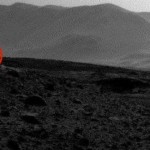
photo credit: NASA/JPL-Caltech
This past January, NASA’s Opportunity rover sparked a bit of debate when it imaged a mysterious rock on Mars that didn’t seem to match other samples in the vicinity. This caused an uproar among bloggers in basements everywhere claiming it was evidence of alien life, but NASA ultimately ruled the rock had been flung to its present location Tiddlywink-style under the rover’s tracks. A similar debate has now been caused by the Curiosity rover due to a mysterious flash of light spotted in two images.
The area where the light is coming from was photographed April 2 & 3rd, but could only be seen with the right eye camera:

Images taken from Curiosity’s right eye camera on April 2 and 3, respectively. Credit: NASA/JPL-Caltech
Yet the light is noticeably absent on the left, even though these images were each taken one second after the ones on the right:

mages taken from Curiosity’s left eye camera on April 2 and 3, respectively. Credit: NASA/JPL-Caltech
NASA isn’t altogether sure what exactly caused the light in this instance, but notes that it is a fairly common occurrence. The most logical explanation is that cosmic rays passed through a leak in the camera’s vent, causing the light to appear on the image. Another simple explanation is that the light is reflecting off of a rock and happened to be caught at just the right angle to be imaged by one camera and not the other.
However, not everyone is buying that. Websites dedicated to discussion about UFOs became inundated with comments about the light being proof of aliens living in underground colonies. (Yes, I went to college and actually just typed out that sentence. Good grief.) They also accuse NASA of inhibiting discovery by not fully investigating the phenomenon.
NASA is not wasting any energy by entertaining the thought of underground aliens and is preferring to focus on realistic possibilities first. The light appears about 175 yards (160 meters) from where Curiosity was at the time. Since Curiosity travels at about 98 feet per hour, there’s a good chance that it won’t waste a precious day of research to go investigate the area and get back to its regular mission.
Curiosity has just reached the Kimberley Waypoint and has begun to take geological samples. The area could possibly be a good site for drilling and could reveal information about the ancient Martian landscape.
Yes, the images in the article are heavily cropped in order to make the small, distant light appreciable on the size parameters of this website. If you wish to see the originals, click on the hyperlinks for right camera April 2, April 3 and left camera April 2, April 3.








 Photographer Finds Locations Of 1960s Postcards To See How They Look Today, And The Difference Is Unbelievable
Photographer Finds Locations Of 1960s Postcards To See How They Look Today, And The Difference Is Unbelievable  Hij zet 3 IKEA kastjes tegen elkaar aan en maakt dit voor zijn vrouw…Wat een gaaf resultaat!!
Hij zet 3 IKEA kastjes tegen elkaar aan en maakt dit voor zijn vrouw…Wat een gaaf resultaat!!  Scientists Discover 512-Year-Old Shark, Which Would Be The Oldest Living Vertebrate On The Planet
Scientists Discover 512-Year-Old Shark, Which Would Be The Oldest Living Vertebrate On The Planet  Hus til salg er kun 22 kvadratmeter – men vent til du ser det indvendigt
Hus til salg er kun 22 kvadratmeter – men vent til du ser det indvendigt  Superknepet – så blir snuskiga ugnsformen som ny igen!
Superknepet – så blir snuskiga ugnsformen som ny igen!  Meteorite That Recently Fell in Somalia Turns Out to Contain Two Minerals Never Before Seen on Earth
Meteorite That Recently Fell in Somalia Turns Out to Contain Two Minerals Never Before Seen on Earth  Nearly Frozen Waves Captured On Camera By Nantucket Photographer
Nearly Frozen Waves Captured On Camera By Nantucket Photographer  It’s Official: Astronomers Have Discovered another Earth
It’s Official: Astronomers Have Discovered another Earth 